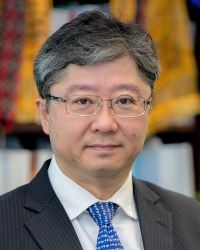Young faces filled the bustling Manila train, and one face stood out. In his mid-50s, Professor Yasuyuki Sawada often found himself to be the oldest among his fellow commuters.
The chief economist of the Asian Development Bank from 2017 to 2021, Prof Sawada found himself in a different situation when he moved to Japan. Now his fellow train commuters look similar to his age.
Some Asian countries have younger populations than others. But both emerging and developed Asian countries are ageing rapidly. The ageing populations lead to many fundamental changes at the individual and societal levels. Population ageing also shifts government priorities and policies.
The ageing population topic took centre stage at a virtual Academic Luncheon Panel organised by the Asian Bureau of Finance and Economic Research (ABFER) housed at NUS Business School. The event was part of ABFER’s 9th Annual Conference.
Sharing their insights during the Academic Luncheon Panel were two eminent economists—Prof Yasuyuki Sawada from the Faculty of Economics at the University of Tokyo and Prof Zhao Yaohui from the China Centre for Economic Research at Peking University. Prof Fang Hanming, Joseph M. Cohen Term Professor of Economics, University of Pennsylvania and Senior Fellow of ABFER, chaired the session.
Prof Yasuyuki Sawada: Finding the next population dividend
People in Asia are living longer. A person born in Asia in 1960 has an average life expectancy of 45 years; a person born some 50 years later has an average life expectancy of more than 70 years.
In those 50 years, Asia’s population boomed to become the largest among the other continents. They also become healthier and more educated, forming a larger and more-skilled workforce contributing to countries’ economies.
Indeed, Asia has enjoyed increasing population dividends in the last few decades—accelerated economic growth due to the changing population demographics.
“Now, many Southeast Asian and South Asian countries are still enjoying their first population dividend, but we predict this demographic dividend will disappear sooner or later,” said Prof Sawada, whose research interests include development economics.
A second demographic dividend can still arise from a more productive and skilled workforce. Still, this second dividend may be over one day.

A skilled workforce can give rise to a second demographic dividend.
While a healthier and more educated population makes a shrinking workforce seem less dire, concerns remain. Many people have dementia, a disease not curable based on current medical technology.
“One mechanism to soften this negative consequence is to tap a third demographic dividend, also known as a silver dividend,” said Prof Sawada. When the elderly stay healthy and work, they contribute to economic development.
There is room for governments in Asia to develop old-age support in financing and well-being. But there is a dilemma. The younger generation’s attitudes changed when Japan introduced universal health coverage and in-home care options for the elderly. Over the years, the young increasingly do not see supporting their aged parents as a natural duty. It is a concern because, among Asian developing countries, public support for the aged is still developing. Yet, on the other hand, values towards private support, such as family support, have changed.
With Asian countries ageing at different speeds and trajectories, countries can perhaps tap on cross-border labour and capital mobility to soften the blow of an ageing population.
Prof Zhao Yaohui: Getting ready for the silver generation
Prof Zhao knows about ageing. She is the principal investigator of the China Health and Retirement Longitudinal Study, commonly known as CHARLS, a nationally representative sample survey of Chinese residents aged 45 and older.
In China, the official retirement age is 60 for men and 55 for women in white-collar jobs. But Prof Zhao’s study found that city dwellers were retiring too early.
Around 60 per cent of women aged 55 to 59 can work but are not working. “For men and women in their 60s, the excess work capacity is close to 50 per cent, so it’s really substantial,” said Prof Zhao.
When people lose their ability to work, most urban dwellers said they would rely on their pensions, while rural dwellers said they would depend on their children, meaning social support will be very important in the future.
Prof Zhao said there are pending areas of research, such as understanding the permanence of health at old age, which will help pinpoint policy intervention areas. Researchers are also keen to study policy innovation and reform that encourages later retirement, as well as ways to provide financial security to older people while meeting their current needs.

Support for the well-being of the elderly is important.
In the Q&A session, the professors gave their views on various topics.
On fertility
Prof Zhao: Improving fertility can solve some but not all of the ageing issues, because the latter is predominantly due to increased life expectancy. But fertility can alleviate population ageing, so I agree that we should encourage more fertility.
Childcare for children aged zero to three years old is severely lacking in China. Providing childcare can hopefully reduce the cost for career women to have children.
Prof Sawada: Japan’s total fertility rate (TFR) has been the lowest among East Asian countries, but now, TFR is shrinking more dramatically in China and South Korea. I think people in Japan are already aware of the importance of having children. Many Japanese municipalities provide monetary and non-monetary incentives for couples with children. As a result, Japan’s TFR seems to be stabilised. Supporting couples in raising children is a larger and broader human capital investment. I think these efforts are very much necessary to stop further TFR decline.
On pensions
Prof Zhao: China now embraces the third pillar in its pension system—personal pensions. It’s based on individual accounts and is available for employees in more informal sectors such as the platform economy. If this becomes successful, then it may become a model of reform.
On lessons from Japan’s ageing experience
Prof Sawada: I think all the support programmes and policies should be set in a very early stage of population change. Japan established its pension system and universal health coverage in 1961, we now have good social insurance and social security for the elderly, although financial sustainability is another issue we must tackle. Developing countries enjoying high growth built on their first demographic dividend should start establishing social insurance programmes in preparation for the upcoming ageing population.








